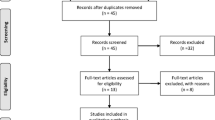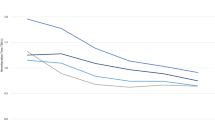Abstract
Increasing numbers of young children spend extended portions of their days in group care settings. However, little attention has been given to the acoustical properties of these settings and how these may affect development, particularly speech and language development. This article provides a review of how classroom acoustics are measured, what researchers have found, and why poor classroom acoustics are of concern, particularly for infants and toddlers. It concludes with recommendations for improving classroom acoustics and verbal communication in the classroom.
Similar content being viewed by others
References
American Speech-Language-Hearing Association. (1995, March). Position statement and guidelines for acoustics in educational settings. ASHA, 37(Suppl. 14), 15-20.
American Speech-Language-Hearing Association. (1997). Noise 〈http://www.asha.org/hearing/disorders/noise.cfm〉.
Bess, F. H., Sinclair, J. S., & Riggs, D. (1984). Group amplification in schools for the hearing impaired. Ear and Hearing, 5, 138-144.
Blair, J. (1977). Effects of amplification, speechreading, and classroom environment on reception of speech. Volta Review, 79, 443-449.
Bradley, J. S. (1986). Speech intelligibility in classrooms. Journal of the Acoustical Society of America, 80, 846-854.
Crandell, C. C., & Bess, F. (1987) Developmental changes in speech recognition in noise and reverberation. ASHA, 29, 170.
Crandell, C. C., & Smaldino, J. J. (1994). An update of classroom acoustics for children with hearing impairment. The Volta Review, 96, 291-306.
Crandell, C. C., & Smaldino, J. J. (1995). Classroom acoustics. In R. J. Roeser & M. P. Downs (Eds.). Auditory Disorders in School Children: The Law, Identification, Remediation, 3rd edition, (pp. 219-234). New York: Thieme Medical Publishers, Inc.
Crandell, C. C., Smaldino, J. J., & Flexer, C. (1999). An overview of sound field FM amplification. The Hearing Review, 6(6), 40-42.
Crum, D., & Matkin, N. (1976). Room acoustics: the forgotten variable. Language, Speech, Hearing Services in Schools, 7, 106-110.
Elliott, L. (1979). Performance of children aged 9 to 17 years on a test of speech intelligibility in noise using sentence material with controlled word predictability. Journal of the Acoustical Society of America, 66, 651-653.
Elliott, L. (1982). Effects of noise on perception of speech by children and certain handicapped individuals. Sound and Vibration, 71 (Dec), 9-14.
Feagans, L. V., Kipp, E., & Blood, I. (1994). The effects of otitis media on the attention skills of day-care-attending toddlers. Developmental Psychology, 30, 701-708.
Feagans, L. V., Hannan, K., & Manlove, E. E. (1992). An ecological and developmental/contextual approach to intervention with children with chronic otitis media. In F. H. Bess & J. W. Hall (Eds.), Screening for auditory function. Nashville: Bill Wilkerson Center Press.
Feagans, L. V., & Proctor, A. (1994). The effect of mild illness in infancy on later development: The sample case of the effects of otitis media (middle ear effusion). In C. B. Fisher & R. M. Lerner (Eds.), Applied developmental psychology, pp. 139-173. New York: McGraw Hill, Inc.
Finitzo-Hieber, T., & Tillman, T. (1978). Room acoustics effects on monosyllabic word discrimination ability for normal and hearing-impaired children. Journal of Speech and Hearing Research, 21, 440-458.
Frank, T., & Golden, M. V. (1999). Acoustical analysis of infant/toddler rooms in daycare centers. Journal of the Acoustical Society of America, 106(4,2), 2172.
Frank, T., Golden, M. V., & Manlove, E. E. (2001, April). Acoustical conditions in infant/toddler daycare classrooms. Poster presented at the Biennial Meeting of the Society for Research in Child Development, Minneapolis, MN.
Gravel, J. S., & Wallace, I. F. (1992). Listening and language at 4 years of age: Effects of early otitis media. Journal of Speech and Hearing Research, 35, 588-595.
Hodgson, M. (1999). Experimental investigation of the acoustical characteristics of university classrooms. Journal of the Acoustical Society of America, 106, 1810-1819.
Houtgast, T. (1981). The effect of ambient noise on speech intelligibility in classrooms. Applied Acoustics, 14, 15-25.
Nabelek, A., & Robinson, P. (1982). Monaural and binaural speech perception in reverberation for listeners of various ages. Journal of the Acoustical Society of America, 71, 1242-1248.
National Association for the Education of Young Children. (1998). Accreditation criteria and procedures of the National Association for the Education of Young Children, 1998 Edition. Washington, DC: author.
Olsen, W. O. (1998). Average speech levels and spectra in various speaking/listening conditions: A summary of the Pearson, Bennett, & Fidell (1977) report. American Journal of Audiology, 7(2), 21-25.
Painter, S., & Frank, T. (1999). Ambient noise levels in infant/toddler rooms in daycare centers. Poster presented at the Convention of the AAA, Miami, FL.
Picard, M., & Boudreau, C. (1998, December). Characteristics of the noise found in daycare centers. Paper presented at the meeting of ASA-EAA-DEGA, Berlin, Germany.
Stool, S. E., Berg, A. O., Berman, S., Carney, C. J., Cooley, J. R., Culpepper, L., Eavey, R. D., Feagans, L. V., Finitzo, T., Friedman, E. M., et al. (1994). Otitis media with effusion in young children: Clinical practice guideline, number 12. (AHCPR Publication No. 94-0622). Rockville, MD: U.S. Department of Health and Human Services, Agency for Health Care Policy and Research, Public Health Service.
Tharpe, A. M., & Bess, F. H. (1999). Minimal, progressive, and fluctuating hearing losses in children: Characteristics, identification, and management. Pediatric Clinics of North America, 46, 65-78.
Vernon-Feagans, L., Manlove, E. E., & Volling, B. L. (1996). Otitis media and the social behavior of day-care-attending children. Child Development, 67, 1528-1539.
Rights and permissions
About this article
Cite this article
Manlove, E.E., Frank, T. & Vernon-Feagans, L. Why Should We Care About Noise in Classrooms and Child Care Settings?. Child & Youth Care Forum 30, 55–64 (2001). https://doi.org/10.1023/A:1016663520205
Issue Date:
DOI: https://doi.org/10.1023/A:1016663520205




